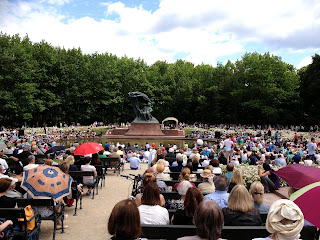 |
| Brandenburg Gate, Berlin's iconic landmark |
Berlin is not new to us. We came here three years ago. This cosmopolitan city may not be so appealing to some tourists, but its historical significance cannot be discounted. Berlin had a wall that remains a symbol for the cold war between the west and the communists.
In August 1961, the East Germany began to install a barbed wire between the east Berlin and west Berlin and all of sudden a wall started rising. The formal reason was to prevent the western fascists from contaminating the socialist nation, but the real reason was to prevent the residents of East Germany from crossing to the west freely. Not too many people foresaw what the wall meant. The wall not only divided the city but also the hearts of many people.
This Berlin Wall stood for 27 years until November 1989 when the East Germany made an announcement that the citizens of East Germany may freely travel to the west. Many people start demolishing the wall and part of the wall still remains as the evidence of the pains and sorrow many people had to endure for the 27 years.
That is why the city was bustling with people despite the rain.
Berlin has a river that flows through the city. In sunny days, people come out for sunbathing without exception. You can do the river cruise to see the city, hop on and hop off.
Berlin's iconic landmark is Brandenburg Gate that is the 18th century triumphal arch. It signifies the ups and downs of the Germany's relationship with Europe, but also symbolizes the European unity and peace.
Unfortunately, it was raining when we went out to see the city. We chose to take a hop-on and hop-off bus tour. We stopped over at Checkpoint Charlie where the citizens of East Germany had to pass through to enter the west. We ate Berlin's famous food Curry Wurst. We also saw the old-fashioned Travi cars.
We also stopped over at Berlin Cathedral, one of the largest building in Berlin. We climbed all the way to the top to see the city. The scenery was panoramic and the interior was gigantically beautiful.
We could skip everything else, but not the East Side Gallery. This gallery represents a portion of the Berlin Wall that has been preserved and more than 180 artists from 21 countries left their paintings related to the Berlin Wall. This was our second time visit, but almost all paintings were damaged by graffitis. Sad. Nonetheless, we took a look at the historic site again with a pondering mind about the evilness of human being.
We took the train again and got off at the Alexanderplatz, a prominent shopping center, but not for shopping but to take a lift to go all the way up to the observatory at the Berlin TV Tower or Fernsehturm in German, the tallest building in Berlin and Germany. It is taller than the Eiffel Tower and far taller than the Statue of Liberty with a height of 368 meters. The ultra fast lift took us up there in 41 seconds. the scenery was not as impressive as expected, but we had a delicious dinner first and we were content.
 |
| At the observatory of the tower |
If allowed, we wanted to walk up to the top of the Parliament Glass Dome, but it required a prior reservation. Anyway, given the rainy weather, we spent pretty good amount of time exploring the city.
The following day, we departed this cosmopolitan city of Berlin to head back to Amsterdam. On the way, we stopped over at a city called Hannover for lunch. This is where Volkwagen Tower is located. We enjoyed our lunch, but we saw many homeless people on the street. This reminded me that Germany has its own issues to address internally.
 |
| Volkwagen Tower |
 |
| Snapshots of Hannover |
I am ever grateful for the opportunity that I had in exploring the northern European countries in Baltic and Scandinavian region. - Jeffrey


























































